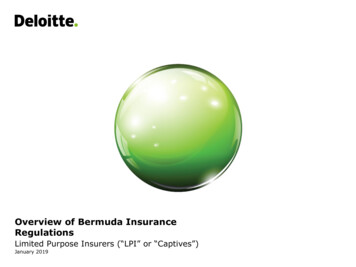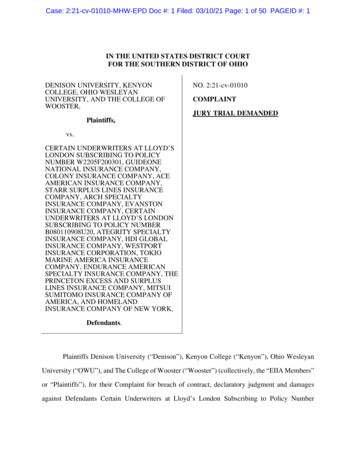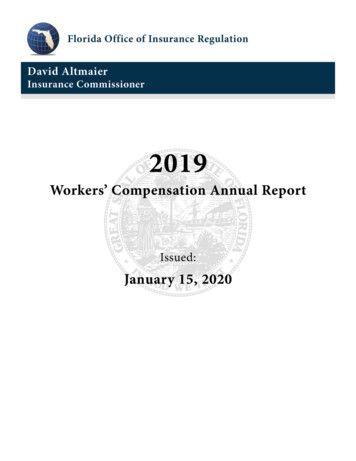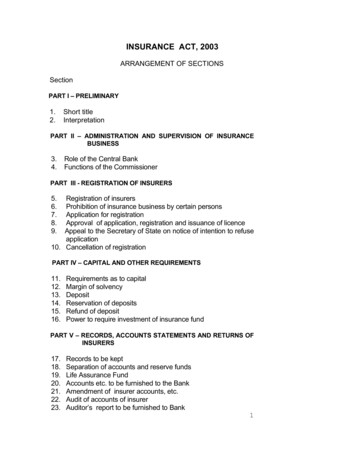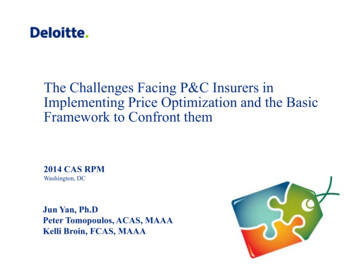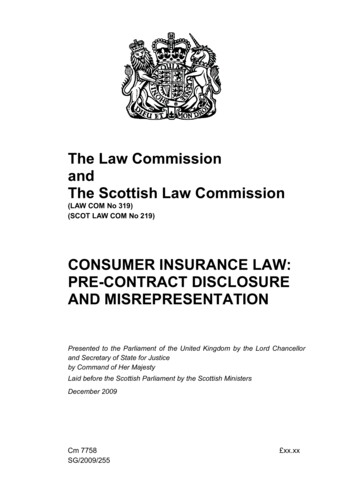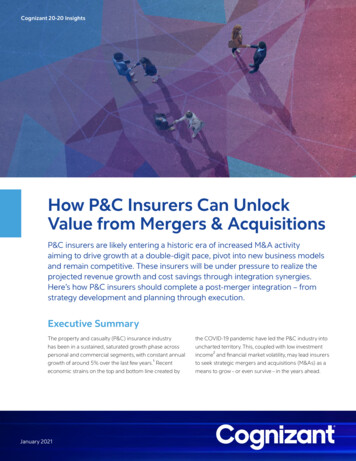
Transcription
Cognizant 20-20 InsightsHow P&C Insurers Can UnlockValue from Mergers & AcquisitionsP&C insurers are likely entering a historic era of increased M&A activityaiming to drive growth at a double-digit pace, pivot into new business modelsand remain competitive. These insurers will be under pressure to realize theprojected revenue growth and cost savings through integration synergies.Here’s how P&C insurers should complete a post-merger integration – fromstrategy development and planning through execution.Executive SummaryThe property and casualty (P&C) insurance industryhas been in a sustained, saturated growth phase acrosspersonal and commercial segments, with constant annual1growth of around 5% over the last few years. Recenteconomic strains on the top and bottom line created byJanuary 2021the COVID-19 pandemic have led the P&C industry intouncharted territory. This, coupled with low investment2income and financial market volatility, may lead insurersto seek strategic mergers and acquisitions (M&As) as ameans to grow – or even survive – in the years ahead.
Cognizant 20-20 InsightsThe P&C industry has experienced manyacquisitions over the years. However, our financialanalysis of the carriers over years of pre- andpost-acquisition found that many carriers have notachieved both growth and cost synergies. Basedon our experience, most post-merger integrationsstill take much longer than originally anticipated.There are many obstacles in such blendings, whichhave led to delays and lost synergies. Insurersface complex decisional hurdles, typically in theirbusiness operations and IT integrations, due toan unclear understanding of scope, priorities,cross-dependencies and challenges. Some of thekeys to success are having a robust integrationplan, adopting an agile approach with a focuson minimum viable product (MVP) releases ofintegrated processes or platforms, and engaging astrategic partner to help guide the business throughthe process.This white paper will cover key aspects of postmerger integration (PMI) and introduce a frameworkbased on our experiences from past programs. Wealso have recommendations to help the integrationmanagement office effectively orchestrate alloperations.2 / How P&C Insurers Can Unlock Value from Mergers & Acquisitions
Cognizant 20-20 InsightsPost-merger integration: A value multiplierP&C insurance is a moderate growth industry withboth personal and commercial segments highlyfragmented (see Figure 1), with no dominant playerand intense competition to capture market share.Today, along with finding new avenues for growth,insurers must address multiple challenges such asevolving stakeholder expectations, the rise of newerbusiness models from increasing penetration ofIoT devices, and impacts from the pandemic andransomware attacks. To outperform competitors,many insurers seek inorganic growth by enteringnew markets, regions, segments and service areasthrough acquisitions. P&C M&A activity is expectedto rise as insurers strive to emerge stronger from thepandemic.2019 U.S. market share for insurance segmentsPERSONAL LINESOthers – 15%American Family – 3%Travelers – 3%Nationwide – 4%Farmers – 6%State Farm – 22%Allstate – 12%Geico – 12%Progressive – 9%Liberty Mutual – 7%USAA – 7%SMALL COMMERCIAL LINESOthers – 48%(AmTrust, Fairfax, etc.)New entrants &D2C focused carriers – 7%(Chubb, BerkshireHathaway, Hiscox)Large commercial carriers – 15%(The Hartford, LibertyMutual, Travelers)Large personal carriers – 15%(State Farm, Farmers,Progressive, Nationwide)Super-regionals – 15%(Auto-Owners, Erie Insurance,Westfield, Cincinnati, Selective,Philadelphia, Sentry, Hanover)MID/LARGE COMMERCIALAND SPECIALTY LINESOthers – 60%Large commercial carriers – 40%(Travelers, Zurich, LibertyMutual, AIG, The Hartford,Chubb, AXA XL, CNA)Source: Cognizant analysis based on NAIC and other secondary sourcesFigure 13 / How P&C Insurers Can Unlock Value from Mergers & Acquisitions
Cognizant 20-20 InsightsMany multibillion-dollar deals have closed in the last3few years. Our analysis of six large P&C acquisitionsover the past eight years shows mixed results on theresultant growth and expense ratios, as shown inFigure 2. Most carriers that improved growth havehigher expense ratios in the following years. Likewise,most carriers that contained their expense ratioswere unable to realize accelerated growth.Only two of the six carriers analyzed achieved bothgrowth and expense synergies from the M&A,with only one of them achieving growth above theindustry average. Some of the key reasons for thedelayed and suboptimal results include: Lack of an effective PMI strategy and a clearexecution direction aligned with the overallbusiness vision. Lack of technical depth among the integrationpartners, and their failing to understand andforesee roadblocks with the typically complexlegacy processes and systems across bothorganizations. Lack of an effective governance structurerequired to make decisions with execution pace,change management, communications, earlyrealization of value and guidance to teams.Many insurers will accelerate inorganic growththrough M&As as a means of expanding intonew markets (e.g., specialty, excess and surplus),geographies (e.g., international or state-wideexpansions), industry segments and risks (e.g.,ride-sharing providers and other sharing economyproviders), and also adopting new businessmodels, such as peer-to-peer insurance or episodicinsurance. The key to ensure best outcomes andfaster synergy is an effective PMI strategy – fromplanning to execution.Pre- and post-merger growth and expense ratios of large P&C carriersthat went through M&A activities in the past eight yearsOnly cost reduction synergyGrowth and cost reduction synergyExpense ratio reduction, but with slackened GWPExpense ratio reduction, with increased GWPExpense ratio reduction %(three years pre-M&A to three years post-M&A)–6.0%–4.0%Carrier C–2.0%Carrier A-5.0%-3.0%Carrier B-1.0%Carrier F0.0%1.0%2.0%Carrier D4.0%No synergyIncreased expense ratios and decreased growth6.0%3.0%5.0%Carrier EOnly growth synergyIncreased GWP but with increased expense ratioGross written premium (GWP) change % (three years pre-M&A to three years post-M&A)Source: Cognizant analysis based on data from NAIC, annual reports and secondary sourcesFigure 24 / How P&C Insurers Can Unlock Value from Mergers & Acquisitions
Cognizant 20-20 InsightsCharting the building blocks for effective integrationsA PMI may span multiple geographies, productgroups and business units. This results in a breadthof integration activities across business areas andoperating models including organizational structure,products, distribution channels, people, processesand technologies – such as applications, end-userservices, servers and databases. A successfulintegration needs to ensure that all dimensions(business, operations, IT and infrastructure) areholistically integrated. An unclear rationalizationand integration strategy will result in lost synergiesand delayed implementations. For example,challenges arriving at a consensus on the clearanceprocesses across business groups have delayedmany submission/intake system integrations. OurP&C insurance PMI framework, as shown in Figure3, includes the key dimensions and subdimensionsthat insurers need to consider and decide upon toensure they realize holistic integration and plannedsynergy benefits.Key business, operations and IT integration dimensions for holistic integrationBrand unification Corporate brand unification. Agent brand messaging. Insured/consumer brandmessaging.Policyholder services operations consolidation1Product consolidation Products/coveragesrationalization. Rates, rules and formsrationalization. Product development andmaintenance processstandardization. Regulatory aspects.2Distribution channelintegration3 Channel conflict resolution. Compensation structure. Agent service center.Underwriting operationsconsolidation Underwriting organization consolidation.Risk appetite & pricing rationalization.Process standardization.Reinsurance contract finalization& process standardization.Source: CognizantFigure 3 564Policy management and billing organization consolidation.Policy management process standardization.Billing process standardization.Customer service center consolidation.Claims operations consolidation Claims organization consolidation. Claims process standardization. Claims service center consolidation.Corporate services reorganization789 Actuarial department. Corporate finance department. HR, legal and compliance departments.Real estate and facilities consolidation Real estate consolidation. Facilities management consolidation. Vendor consolidation.IT/systems rationalization 10Business applications/systems rationalization.Desktops and enterprise software consolidation.Infrastructure consolidation.IT vendors/contractors consolidation.Integration Management OfficeStrategy, planning, program andchange management.5 / How P&C Insurers Can Unlock Value from Mergers & Acquisitions
Cognizant 20-20 InsightsNavigating the PMI journeyCombining these dimensions in an actionableplan is critical to success. When setting timelinesfor integration and deciding on best approaches,the decisions made will vary depending on thecombining cultures and the intended businessobjectives around the acquisition. Figure 4 depicts arepresentative phase-wise approach to integration,calling out the key challenges and expected businessvalues captured. Additionally, the integration phasesneed not always be linear. Insurers can opt to runworkflows in parallel with an agile mindset. Forexample, insurers may stage their IT consolidationby starting with end-user computing consolidationand then address application consolidation after thebusiness process integration is complete. Integratingbusiness operations and IT are the most challengingand time-consuming but are key to realizingsynergistic value.Phase-wise categorization of the key dimensions across business, operationsand IT integration stagesExamples: Policy administration application rationalization, claimsapplication rationalization, billing application rationalization.Phase 3:Business Case: Cost synergies from reduced IT maintenance cost,reduced integration cost, improved business process efficiency.Complexity level of integrationIT/SystemsChallenges: Program planning, skilled resource availability,business SME availability, integration complexity, conversioncomplexity.Examples: Underwriting organization structure design, UW rolesand responsibilities definition, FNOL process and business rulesstandardization, claims call center operations consolidation.Phase 2:Distribution,underwriting,claims, andpolicyholderservicesBusiness Case: Revenue synergies through cross-sell/up-sellfrom better product portfolio, revenue synergies from additionalsales by becoming a top carrier in agent’s book of business, costsynergies from process/skills integration.Challenges: Channel conflict, agent-underwriter relationship,underwriting culture, relocation of service center personnel.Examples: Logo and tagline design, media placement, productapplication/forms design, job band and title integration, emailstandardization, server/data center consolidation, facilitiesmanagement consolidation.Phase 1:Brand,products,corporateservices, andreal estateBusiness Case: Cost synergies from FTE reduction, facilitiesreduction, vendor consolidation.Challenges: Brand dilution, managing agent/customerperceptions, employee engagement, cultural alignment,labor issues.Synergy valueSource: CognizantFigure 46 / How P&C Insurers Can Unlock Value from Mergers & Acquisitions
Cognizant 20-20 InsightsQuick TakeKey Learnings fromSuccessful PMIsBusiness functions differ widely in their level of integration complexity. Adding to thesecomplexities are business interdependencies, innate challenges with the current technologyand cultural differences. Figure 5 depicts key learnings across functions from our recentexperiences integrating business operations and applications.Key PMI learnings across business functions, working with leading P&C insurersFunctionKey question(s) for insurersOur learningsSubmission/clearanceWhat should be the scope of clearanceacross my segments?Carriers can decide between providing a common clearance (for customer,broker, risk) against the one segment of their business (small, mid-size, large,specialty) or build a common clearance across the enterprise.UnderwritingShould I move underwriting to a commonunderwriting platform or retain theexisting underwriting tools/platforms?The complexities and change management associated with consolidatingunderwriting tools/platforms are higher, though they provide bettereffectiveness and efficiency.Policyadministration/servicingShould I consolidate my policyadministration systems and migratehistorical data?Policy administration consolidation typically has a huge impact on businesscase and should be prioritized. Policy migration can be done at renewals.ClaimsShould I consolidate my claims systemsand migrate historical data?Claims provides better potential for consolidation sooner than other businessapplications. Different options and strategies exist to manage open claims,long-term claims and closed claims.ReinsuranceShould the reinsurance treaties beconsolidated to a common system?Reinsurance complexity is driven by line of business (number of treaties,facilities, etc.). Target solution should be defined early, but “manual” solutionscan work short term.ReportingHow can I provide consolidated business,operational reporting and analytics?Consolidated reporting solution is often complex and involves sourcing andcombining data from multiple sources. Short-term tactical reporting solutionsoften require manual consolidation.FinanceHow can I consolidate premium,receivables accounting functions andclose financial periods?Consolidation of financial systems usually happens prior to consolidationof policy/UW and claims platforms, as executives look at consolidating thepremium reconciliations. Accounting to be streamlined across merged entitiesand close financial periods accurately in a timely manner.Source: CognizantFigure 57 / How P&C Insurers Can Unlock Value from Mergers & Acquisitions
Cognizant 20-20 InsightsIMO: Ensuring success through holistic integrationstrategy, planning and executionThe integration management office (IMO) playsa vital role in integration success, as it managesstrategy, planning and execution. This officerepresents the “home base” that orchestrates allefforts across diverse groups. It is responsiblefor establishing program standards, governance,reporting, change management and measuring KPIsto assess integration program outcomes. An IMOrequires representation from all the business andIT groups involved. Playbooks, skills, methodologiesand tool kits must be cross-leveraged whenprogressing through the many acquisition initiatives.Figure 6 defines the key roles and responsibilities ofan effective IMO.Key roles and responsibilities of the IMOStrategy and planning Road-map and rollout sequence. Foundational planning.Risks and dependencymanagement Risks and issues management. Dependency tracking andmanagement.Change managementProgram managementBusiness case m anagement Develop and manage programtimelines. Develop and manage business case:benefits & cost. Standardization of hand-offprocesses/activities. Measure progress and deviation.Integration services Transition services agreement (TSA)management.Infrastructure &end-user computing Develop key integrations betweensystems. End-user device and networkenablement. Review data dependencies andrequirements. Manage infrastructure migration anddata center consolidation.Foundational work/planningMultidisciplinary tracks Change management impactassessment, strategy and plan. Product definition by business unit/profit center. Comprehensive rollout ,communication and adoption plan. Brokers, agents and officerationalization. Product, policy, underwriting, claims,finance, reinsurance, actuarial,reporting. Conversion and migration.Source: CognizantFigure 68 / How P&C Insurers Can Unlock Value from Mergers & Acquisitions
Cognizant 20-20 InsightsThe IMO should ensure proper coverage andoversight of all integration components and helpteams deliver on time and within budget. GuidingIMO principles include: Manage the cultural shift. Never easy, fosteringchange can introduce anxiety and confusionacross management levels and departmentsin both organizations. This often leads tohigher attrition, particularly in functions suchas underwriting, claims and finance. Managingemployee expectations through effectivechange management and strategic and timelycommunications is critical. Retaining employeesin key roles such as underwriters, claims adjustersand actuaries needs special attention as theymay be anxious about their future and the impactof change. Follow an agile path. Successful integrationplanning and execution needs to be agile todeliver value incrementally and quickly and to gainstakeholder trust. Two key considerations include: Business and IT need to approach and executeintegration with an MVP mindset, whichfocuses on incremental business integrationand value delivery. The IMO must ensurethis focus by being the central organizationthat manages the MVP scope and ensuresthe mission stays on track. Scenarios suchas functional enhancements at the portfoliolevel can derail the integration’s scope andtimeliness. Tying changes to what is absolutelyneeded for integration (vs. enhancements) andensuring teams remain steadfast to completeintegration objectives will help organizationsrealize their PMI goals. Keep the scope and assumptions flexible, withroom to make adjustments along the way.For example, regulatory changes, channelresistance and geographic differences oftenlead to unforeseen requirement changes.These types of complex issues – especiallythose related to multinational needs (currency,language) – can impact integration plans.Creatively resolve challenges through workflowchanges. Managing changes, communicationsand rollout through the IMO will enable teamsto focus on their committed milestones.All options need to be evaluated through anexecution lens, and the role of a strategic M&Apartner is not just to define the strategy and planbut to bring learnings from prior integrations,customize approaches and lead execution withan agile mindset. For example, one insuranceM&A MVP addressed claims-system integration,while another M&A focused first on policyadministration consolidation. A clear agile planneeds to be devised during due diligence. Manage scope through integration phases.Conduct the integration in phases based onparameters such as business appetite, speed-tomarket, team availability and required changemanagement. Manage scope closely and treatintegration and transformation requirementsdifferently. In a recent acquisition, the acquiringcarrier focused on integrating the applicationsand business processes to get to one unifiedstate of integration, while planning how to makethat united approach futuristic, through digitaltransformation in distribution. Approachingintegration with undiluted attention helps preventteams from switching contexts and contributes tocompleting the committed integration goals ontime and within budget.9 / How P&C Insurers Can Unlock Value from Mergers & Acquisitions
Cognizant 20-20 Insights Establish rollout and adoption plan. Once theexecution work is divided into releases and waves,devise an effective adoption plan. Starting in anarea with maximum resistance will most certainlystall the program with paralysis-by-analysis. Toavoid such, within each wave leverage a “will vs.ease-of-bill” approach (see Figure 7) to ensuresteps along the journey don’t fall victim to anydelays in decision-making. Recommendationsinclude: Identify the key integration supporters whoare eager to embrace change and can actas change agents. For example, businessfunctions with inefficient workflows are moreopen to adopt change. Leverage these quickwins to inject confidence and break the initialchange inertia with the other business units. Unleash IT capabilities in phases, andincrementally add business value to securebusiness support. Establish federated servicesto streamline business processes impactedby the integration of business applications.This will help minimize disruption until theapplications are rationalized. For example,a central service, such as a federated policyservice, would help downstream systems suchas claims, finance and reporting systems toobtain the required policy information andsupport continued service to customers andinternal users, until the policy systems getrationalized.Example of a will vs. ease-of-bill analysis when planning the journey Will (willingness to support) Ready to accelerate. Start here with believers. Higher level of support. Break inertia. Pipeline for next roundof funding. High level of support. Quick wins. Proof of concepts. Low level of support. Keep accelerating. Calculated risks. Moderate support. Art of the possible. Gather momentum. Finish strong. Amalgamate followers.Ease of bill (availability of funding)Source: CognizantFigure 710 / How P&C Insurers Can Unlock Value from Mergers & Acquisitions
Cognizant 20-20 Insights Set measures, monitor KPIs and communicate.The IMO must establish program standards,governance, methods, tools and KPIs to assessthe complete integration program. Use reportingdashboards and policy standards to provideassurance, transparency and quality control.Scrutinize all work streams to ensure they arein line with the integration guiding principles.Communication forums are established fordifferent levels through which the programprogress, challenges and milestones areconstantly communicated, updated andmonitored. Enforce change managementthrough approval governance. Manage change costs in the cloud. For largePMIs, changes will inevitably surface new needsand threaten to halt various workflows. To moreeffectively address change scenarios, the IMOshould encourage teams to manage activitiesvia cloud platforms. The cloud options rangefrom building short-term, interim solutionsfor the integration through strategic businessapplications . Moving applications into the cloudbrings many benefits, allowing businesses topay for only what they use and gain agility, fasterservices and additional economies of scale. Thistranslates to more efficient cost management andreduces CapEx. During the PMI, it is imperativeto retain and archive all data and applications.Subscription-based cloud archival solutionssave infrastructure costs significantly. Rentservices for migration, which can accelerate themerger without a huge investment to purchaseadditional products. During PMI journeys, legacyapplications tend to live longer than anticipated.Managing the application with a cloud solutionprovides alternate ways to attain cost efficiencies: Move the data center and migrate the legacyapps from on-premises to cloud, resulting inoperational cost reductions. Archive the data onto the cloud when theapplications shut down, making the datahighly reliable while driving the restorationcosts down. Build any new solution for PMI on the cloud,resulting in rapid build-out of environmentsshortening the test cycle across applications. Track synergies and key financials includingthe transition service agreement. The IMOmust meticulously track key metrics such as cashflow, internal rate of return, and net present valueto monitor spending and cost overruns. After thedeal closes, almost every acquisition requires atransition service agreement (TSA) to maintainbusiness continuity. The IMO plays a key role indrafting a TSA that encompasses all scenariosfor running the business and developing thegovernance policies and process to monitor theprovision of transition-related service agreements.Procurement, IT, infrastructure, and finance andaccounting are just a few functions ripe for TSAsynergies. Also, tracking TSAs helps manageday-to-day deliveries, resolve conflicts, ensureinvoice payments are made, identify cost-savingopportunities, and monitor program progressand performance. Establish advisory councils. Many successfulintegrations adopt advisory councils, which areset up by the IMO. In a recent acquisition, the IMOestablished governing councils with multilevelrepresentation from key business units suchas product and underwriting, finance, claims,actuarial and IT. The IMO leveraged these councilsto strengthen project management capabilities,share best practices, review approaches, ensuremilestones are met and encourage continuousimprovements.11 / How P&C Insurers Can Unlock Value from Mergers & Acquisitions
Cognizant 20-20 InsightsThe path forwardA successful integration will unleash significantvalue as the united business expands its portfolioand digital capabilities. As carriers progress inmaking deals, they should consider these criticalsuccess factors: Address PMI feasibility and complexity and theresources required when evaluating deal businesscases and identifying potential synergies. Identify the required elements of a PMI strategyand key decision points. Foster a post-merger mindset that envisions theend state, and follow a phased approach acrossbusiness functions, operations and IT, starting withan MVP implementation. Empower a central IMO that will manage andoversee all integration components, as well as trackthe progress of PMI activities, manage risks andchange, and communicate progress. Involve an ecosystem of strategic partners tosupport the integration, from strategy definitionthrough planning and execution. Early in theprocess, choose a partner that offers businessconsulting and implementation expertise.Endnotes1“COVID-19 to test US P&C insurance industry’s resilience in 2020 and beyond,” S&P Global Market Intelligence, ndustry-s-resilience-in2020-and-beyond.2“P&C insurers’ investment income under ‘strain,’” insurancebusinessmag.com, n-230549.aspx.3“Axa completes 15B acquisition of XL Group, ratings upgraded,” businessinsurance, 2018, 912323959/Axa-completes- 15B-acquisition-of-XL-Group,-ratings-upgraded#.12 / How P&C Insurers Can Unlock Value from Mergers & Acquisitions
Cognizant 20-20 InsightsAbout the authorsAgil FrancisConsulting Leader and Partner, Property & Casualty Insurance PracticeAgil Francis leads Cognizant’s P&C Insurance Advisory Practice, where he focuses on business and digitaltransformation. He has helped develop leading industry solutions and tools to address underwriting, claimsand risk mitigation critical to personal and commercial insurers. He is a senior leader and strategist withbroad expertise in assessing business and operations challenges, developing strategies and deliveringresults. Agil brings extensive experience in driving innovation and change for business transformation. Heand his team have been leaders in identifying how new business models and technologies such as AI, IoT andblockchain can transform insurance products and processes. His specialties include digital transformation,operating model design, distribution, underwriting and claims transformation, and post-merger integration.He was selected as Consulting Magazine’s Top 25 Consultants of 2019. Agil has authored several white paperson emerging business and technology trends and articles in leading publications such as Harvard BusinessReview, Best’s Review, Digital Insurance and Reactions. He can be reached at Agil.Francis@cognizant.com www.linkedin.com/in/agil-francis-86322537.Vikas JainDirector and Principal, Insurance Practice, Cognizant ConsultingVikas Jain has 20 years of management consulting experience in the insurance industry and advises onstrategy, operations and transformation issues across underwriting, claims and distribution functions. He is asenior leader in the P&C Consulting Practice with broad expertise in transforming business and operations,developing strategies and leading large transformation programs. His specialties include post-mergerintegration, operating model transformation and digital transformation. Vikas has authored several whitepapers around trends in the P&C industry. He can be reached at Vikas.Jain@cognizant.com www.linkedin.com/in/ vikas-jain-b02a0724.Sridhar DevarajaluConsulting Manager, Insurance Practice, Cognizant ConsultingSridhar Devarajalu has more than 12 years of experience in the P&C insurance domain. He has experience indefining solution approaches and providing competitive intelligence for insurance carriers globally to addressproblems covering insurers’ digital transformation strategy, customer experience management and processtransformation. Sridhar holds a post-graduate diploma in general management from the XLRI School ofBusiness. He can be reached at Sridhar.Devarajalu@cognizant.com www. linkedin.com/in/sridhardevaraj.13 / How P&C Insurers Can Unlock Value from Mergers & Acquisitions
Cognizant 20-20 InsightsVinodh Stanley StephenConsulting Manager, Insurance Practice, Cognizant ConsultingVinodh Stanley Stephen, a Consulting Manager focused on the insurance industry, has worked with seniorinsurance executives across North America and the Asia-Pacific region. His consulting experience includesbusiness transformation advisory, post-merger integration strategy, innovation advisory, digital strategy,process transformation, operating model redesign, platform modernization and business case development.He has also conceptualized innovative solutions and published in the digital insurance space. Vinodh has amaster’s degree in m
Customer service center consolidation. 8 4 3 7 5 6 10. Integration Management O‡ce. Strategy, planning, program and . synergy benefits. 6 / How P&C Insurers Can Unlock Value from Mergers & Acquisitions . server/data center consolidation, facilities management consolidation. Business Case: Cost synergies from FTE reduction, facilities .
